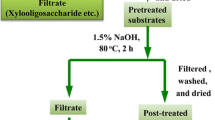Abstract
In addition to fermentable sugars, dilute-acid hydrolysates of lignocellulose contain compounds that inhibit fermenting microorganisms, such as Saccharomyces cerevisiae. Previous results show that phenolic compounds and furan aldehydes, and to some extent aliphatic acids, act as inhibitors during fermentation of dilute-acid hydrolysates of spruce. Treatment of lignocellulose hydrolysates with alkali, usually in the form of overliming to pH 10.0, has been frequently employed as a detoxification method to improve fermentability. A spruce dilute-acid hydrolysate was treated with NaOH in a factorial design experiment, in which the pH was varied between 9.0 and 12.0, the temperature between 5 and 80°C, and the time between 1 and 7 h. Already at pH 9.0, >25% of the glucose was lost when the hydrolysate was treated at 80°C for 1 h. Among the monosaccharides, xylose was degraded faster under alkaline conditions than the hexoses (glucose, mannose, and galactose), which, in turn, were degraded faster than arabinose. The results suggest that alkali treatment of hydrolysates can be performed at temperatures below 30°C at any pH between 9.0 and 12.0 without problems with sugar degradation or formation of inhibiting aliphatic acids. Treatment with Ca(OH)2 instead of NaOH resulted in more substantial degradation of sugars. Under the harsher conditions of the factorial design experiment, the concentrations of furfural and 5-hydroxymethylfurfural decreased while the total phenolic content increased. The latter phenomenon was tentatively attributed to fragmentation of soluble aromatic oligomers in the hydrolysate. Separate phenolic compounds were affected in different ways by the alkaline conditions with some compounds showing an increase in concentration while others decreased. In conclusion, the conditions used for detoxification with alkali should be carefully controlled to optimize the positive effects and minimize the degradation of fermentable sugars.
Similar content being viewed by others
References
Wheals, A. E., Basso, L. C., Alves, D. M. G., and Amorim, H. V. (1999), Trends Biotechnol. 17, 482–487.
Ando, S., Arai, I., Kiyoto, K., and Hanai, S. (1986), J. Ferment. Technol. 64, 567–570.
Clark, T. A. and Mackie, K. L. (1984), J. Chem. Technol. Biotechnol. 34B, 101–110.
Larsson, S., Palmqvist, E., Hahn-Hägerdal, B., Tengborg, C., Stenberg, K., Zacchi, G., and Nilvebrant, N.-O. (1999), Enzyme Microb. Technol. 24, 151–159.
Larsson, S., Reimann, A., Nilvebrant, N.-O., and Jönsson, L. J. (1999), Appl. Biochem. Biotechnol. 77–79, 91–103.
Larsson, S., Quintana-Sainz, A., Reimann, A., Nilvebrant, N.-O., and Jönsson, L. J. (2000), Appl. Biochem. Biotechnol. 84–86, 617–632.
Martinez, A., Rodriguez, M. E., York, S. W., Preston, J. F., and Ingram, L. O. (2000), Biotechnol. Bioeng. 69, 526–536.
Martinez, A., Rodriguez, M. E., Wells, M. L., York, S. W., Preston, J. F., and Ingram, L. O. (2001), Biotechnol. Prog. 17, 287–293.
Nilvebrant, N.-O., Reimann, A., Larsson, S., and Jönsson, L. J. (2001), Appl. Biochem. Biotechnol. 91–93, 35–49.
Ranatunga, T. D., Jervis, J., Helm, R. F., McMillan, J. D., and Wooley, R. J. (2000), Enzyme Microb. Technol. 27, 240–247.
Ranatunga, T. D., Jervis, J., Helm, R. F., McMillan, J. D., and Hatzis, C. (1997), Biotechnol. Lett. 19, 1125–1127.
Persson, P., Andersson, J., Gorton, L., Larsson, S., Nilvebrant, N.-O., and Jönsson, L. J. (2002), J. Agric. Food Chem. 50(19), 5318–5325.
Pigman, W. and Anet, E. F. L. J. (1972), in The Carbohydrates, vol. 1A, Pigman, W. and Horton, D., eds., Academic Press, New York, NY, pp. 165–194.
De Bruijn, J. M., Kieboom, A. P. G., and Van Bekkum, H. (1986), Recl. Trav. Chim. Pays-Bas 105, 176–183.
De Bruijn, J. M., Kieboom, A. P. G., and Van Bekkum, H. (1987), Recl. Trav. Chim. Pays-Bas 106, 35–43.
De Bruijn, J. M., Kieboom, A. P. G., and Van Bekkum, H. (1987), Starch/Staerke 39, 23–28.
Forsskåhl, I., Popoff, T., and Theander, O. (1976), Carbohydr. Res. 48, 13–21.
Yang, B. Y. and Montgomery, R. (1996), Carbohydr. Res. 280, 27–45.
Yang, B. Y. and Montgomery, R. (1996), Carbohydr. Res. 280, 47–57.
De Bruijn, J. M., Kieboom, A. P. G., and Van Bekkum, H. (1986), Sugar Technol. Rev. 13, 21–52.
Martinez, A., Rodriguez, M. E., York, S. W., Preston, J. F., and Ingram, L. O. (2000), Biotechnol. Prog. 16, 637–641.
Author information
Authors and Affiliations
Corresponding author
Rights and permissions
About this article
Cite this article
Nilvebrant, NO., Persson, P., Reimann, A. et al. Limits for alkaline detoxification of dilute-acid lignocellulose hydrolysates. Appl Biochem Biotechnol 107, 615–628 (2003). https://doi.org/10.1385/ABAB:107:1-3:615
Issue Date:
DOI: https://doi.org/10.1385/ABAB:107:1-3:615



